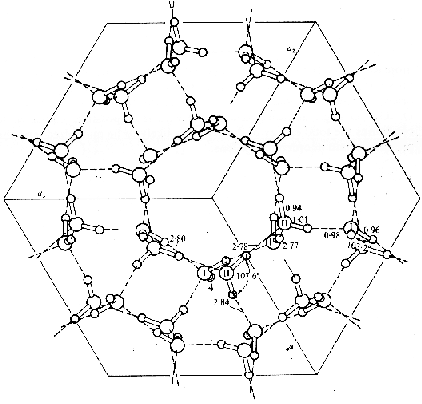
 The ice we encounter in everyday life is known as ice-I in the
Bridgman nomenclature. Additional phases, called ice II through ice
IX, have been created under special laboratory conditions.
``Except at temperatures lower than those occurring naturally on
the earth, none of these ices can exist at pressures of less than 2000
atm. Since the thickest ice sheet in the world - in Antarctica - is
less than 4000 m thick, corresponding to a maximum pressure at the
base of the ice of about 350 atm, it is clear that none of these
artificial ices can normally exist on the earth.'' (Pounder, 1965,
p. 10)
The ice we encounter in everyday life is known as ice-I in the
Bridgman nomenclature. Additional phases, called ice II through ice
IX, have been created under special laboratory conditions.
``Except at temperatures lower than those occurring naturally on
the earth, none of these ices can exist at pressures of less than 2000
atm. Since the thickest ice sheet in the world - in Antarctica - is
less than 4000 m thick, corresponding to a maximum pressure at the
base of the ice of about 350 atm, it is clear that none of these
artificial ices can normally exist on the earth.'' (Pounder, 1965,
p. 10)
This figure shows the nine phases of ice as a function of temperature
and pressure. Normal ice exists in the region marked Ih. The ``h''
stands for hexagonal. The figure is from (Hobbs, 1974, p. 61), after
a figure from (Whalley, 1969).

The hexagonal crystal structure of ice-Ih. The numbers refer to individual water molecules. From (Hobbs, 1974, p. 35.)
This is the ordinary ice you find in your freezer.

``Structure of ice II, viewed along the hexagonal c-axis. Hydrogen bonds between the water molecules are shown as dashed lines. Lengths are in angstroms.'' (Hobbs, 1974, p. 69, reproduced from Hamilton et al., 1969).
Ice II exists only at pressures greater than 2000
atmospheres.
``Whalley et al. (1968) discovered and named ice IX... In 1963 Kurt
Vonnegut described in his science fiction novel Cat's Cradle the
properties of a fictional form of ice, which he called ice IX, which
was capable of crystallizing all the water in the world. The
properties of ice IX described by Whalley et al. are somewhat more
mundane!'' (Hobbs, 1974, p. 66)
Kurt Vonnegut's brother Bernard
held a PhD in physical chemistry from MIT, and published several
papers on silver iodide and ice formation (cloud seeding).
At left is the structure of Whalley et al.'s ice IX, viewed along the
tetragonal c-axis. From (Hobbs 1974, p. 71, reproduced from Hamilton
et al., 1969).

References:
Dave Touretzky
Last modified: Tue Mar 31 00:59:26 EDT 2015